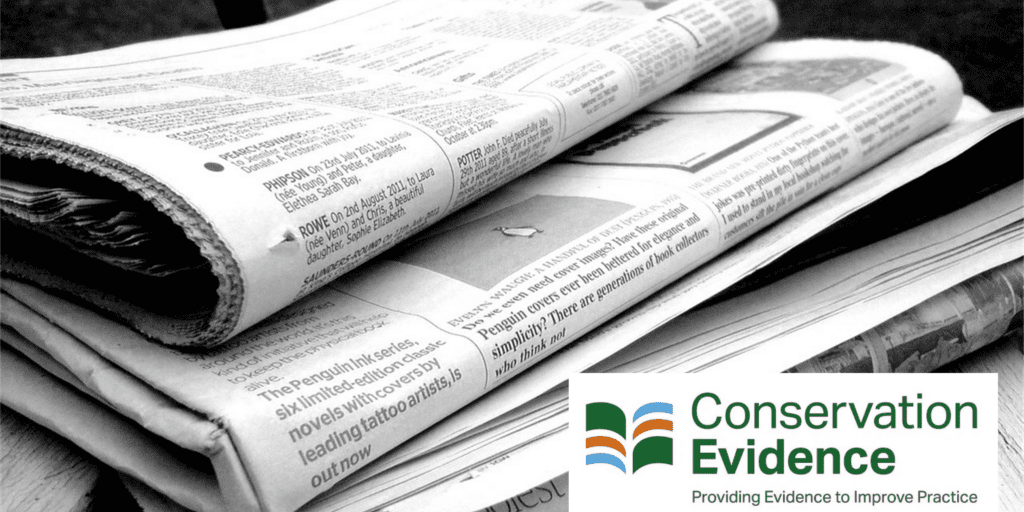“Show me the money!”: Poor reporting of costs of conservation interventions hampers ability to prioritize funds for nature
Tom White is a PhD student with the Conservation Evidence team, where his researches focusses on trying to understand the costs associated with costs of conservation interventions. Today he discusses his most recent publication.
Recent influential reports have highlighted the extent of biodiversity loss globally. For example, the WWF Living Planet report found that monitored populations of species have declined by, on average, 68% between 1970 and 2016 (WWF 2020). The Intergovernmental Platform on Biodiversity and Ecosystem Services (IPBES) have estimated that 1 million species are at risk of extinction (IPBES 2019). Conservationists have argued that to reverse these trends will require transformative conservation action, with changes across society (Leclere et al 2020).
But conservation doesn’t have enough money. In 2020, researchers from the Paulson Institute Paulson Institute (2020) indicated that of the US$722-967 billion estimated to be required each year to reverse the decline of biodiversity, only US$124-143 billion is received. At the same time our spending on some activities that degrade nature is 2-4 times larger. We therefore need i) massive increases in funding coming into conservation, ii) to limit the flows of damaging finances, and iii) efficient spending of the pounds and dollars we have available.

To achieve the last of these requires information on both the effectiveness of actions, and the financial costs of implementing them. A lot of progress has been made in collating and synthesizing the effectiveness of actions with several repositories of information available that collect and summarize available evidence (e.g. CEE, Conservation Evidence, Evidensia, IUCN Panorama). But in order to achieve the best outcomes possible within our available budget, we need information on finances. How much do these different interventions cost?
To attempt to build a database of costs, we looked through papers included in Conservation Evidence database. We wanted to see what percentage of papers would report costs, and how this differed between types of papers in the database.
We reviewed 1,987 papers and found that only 8.8% of papers reported the total cost of the intervention being tested (White et al 2022). When papers did report costs, the reporting was often unstandardized and missing important information. For example many papers did not say what was included or excluded from totals. This makes it difficult for conservationists to use this information, as it is difficult to know whether or not the costs are relevant to your circumstance. For example we may ask “did they have to pay labour costs?”, or “did their total include the costs of machinery?”.

We found different rates of reporting by geography, with higher rates of reporting in some parts of the global south. We also identified that specific types of interventions seemed to be better costed such as measures taken by farmers to promote biodiversity on their land, interventions focused on invasive species control, or interventions conducted as part of transport/construction projects. One possible reason for higher reporting of costs for these types of interventions is the closer link to economics with these projects: invasive species often have large well-quantified costs associated with their spread, farmers often have to conduct conservation measures as part of their business, and those managing construction projects have tightly controlled budgets and timeframes.
As has been highlighted by others, we recommend standardized reporting of the direct costs of actions where total costs are reported, split down into different components, and alongside important contextual information needed to interpret costs of actions (Iacona et al 2018). Frameworks have been developed to consider the direct accounting costs of projects (Iacona et al 2018), as well as the wider economic costs and benefits of action (e.g. opportunity costs, avoided costs etc.) (White et al 2021). To facilitate the change needed, this increased reporting should be combined with the increased consideration of costs in decision-making. For example, a recent study showed that economic evaluation tools are being used increasingly in conservation (although currently at a low level) (Pienkowski et al 2021).
In most cases, someone will know the costs of conservation actions. It is possible they are reported elsewhere or recorded internally at different organisations. However, if such information does not make its way into the published literature, then this can prevent others benefiting from this knowledge, and using this information to prioritize different conservation actions. As a community, let’s share our knowledge of the costs of interventions and projects, and gain a better understanding of the finance and economics of actions.
Let’s show each other the money. Doing so, will help us make better decisions about how we allocate our hard-earned funding – achieving the best conservation outcomes possible with the resources available.
Coauthors: Dr Silviu Petrovan, Dr Alec Christie, Dr Philip Martin, Professor William Sutherland.
The paper is published in BioScience.
References and further reading
White et al (2020) – https://academic.oup.com/bioscience/advance-article/doi/10.1093/biosci/biac007/6549353
WWF (2020) – https://livingplanet.panda.org/en-gb/
IPBES (2019) – https://ipbes.net/news/global-assessment-summary-policymakers-final-version-now-available
Leclere et al (2020) – https://www.nature.com/articles/s41586-020-2705-y
Paulson Institute (2020) – https://www.paulsoninstitute.org/conservation/financing-nature-report/
Iacona et al (2018) – https://conbio.onlinelibrary.wiley.com/doi/10.1111/cobi.13195
White et al (2021) – https://osf.io/kd83v/
Pienkowski et al (2021) – https://conbio.onlinelibrary.wiley.com/doi/10.1111/csp2.357



